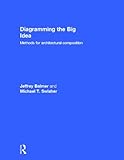Diagramming the big idea : methods for architectural composition / Jeffrey Balmer & Michael T. Swisher.
Material type: TextPublisher: New York : Routledge, 2012Description: xiii, 242 pages ; 29 cmContent type: text Media type: unmediated Carrier type: volumeISBN: 9780415894081; 0415894085; 9780415894098; 0415894093; 0203103599; 9780203103593Subject(s): Architectural design | Architecture -- Composition, proportion, etc | ARCHITECTURE -- Design, Drafting, Drawing & Presentation | ARCHITECTURE -- Reference | ARCHITECTURE -- Study & Teaching | Architectural design | Architecture -- Composition, proportion, etc | Architectural design | Architecture -- Composition, proportion, etcDDC classification: 720.28/4 LOC classification: NA2750 | .B3225 2012Other classification: ARC004000 | ARC012000 | ARC013000 | TU2
TextPublisher: New York : Routledge, 2012Description: xiii, 242 pages ; 29 cmContent type: text Media type: unmediated Carrier type: volumeISBN: 9780415894081; 0415894085; 9780415894098; 0415894093; 0203103599; 9780203103593Subject(s): Architectural design | Architecture -- Composition, proportion, etc | ARCHITECTURE -- Design, Drafting, Drawing & Presentation | ARCHITECTURE -- Reference | ARCHITECTURE -- Study & Teaching | Architectural design | Architecture -- Composition, proportion, etc | Architectural design | Architecture -- Composition, proportion, etcDDC classification: 720.28/4 LOC classification: NA2750 | .B3225 2012Other classification: ARC004000 | ARC012000 | ARC013000 | TU2 | Item type | Current library | Call number | Copy number | Status | Notes | Date due | Barcode |
|---|---|---|---|---|---|---|---|
 Books
Books
|
Main Library | NA2750 .B3225 2012 (Browse shelf (Opens below)) | 1 | In transit from Main Library to Female Library since 04/05/2022 | STACKS | 51952000210542 |
Browsing Female Library shelves Close shelf browser

|

|

|

|

|

|

|
||
| NA2728 .T36 2013 Rendering in SketchUp : from modeling to presentation for architecture, landscape architecture, and interior design / | NA2750 .A556 2017 The architect's studio companion : rules of thumb for preliminary design / | NA2750 .A94 2012 The designer's guide to doing research : applying knowledge to inform design / | NA2750 .B3225 2012 Diagramming the big idea : methods for architectural composition / | NA2750 .B35 2007 The built environment : a collaborative inquiry into design and planning / | NA2750 .C55 2005 Precedents in architecture / | NA2750 .E45 2016 Design management / |
Includes index.
"A beginning design student needs to learn to think like a designer, to visualƠize ideas & concepts as well as objects. In Diagramming the Big Idea, Jeffrey Balmer and Michael T. Swisher illustrate how student architects can create and use diagrams to clarify their understanding of both particular projects and organizing principles and ideas. With accessable, step-by-step exercises that interweave diagrams, drawings and virtual models, the authors clearly demonstrate how to compose meaningful and useful diagrams. As they follow the development of the four projects groups drawn from the authors' teaching, readers will become familiar with architectural composition concepts such as proportion, site, form, hierarchy and spatial construction. In addition, description and demonstration essays extend concepts with further examples of the methods used in the projects. Whether at 3:00 AM during an all-nighter, while preparing for a desk critique or any time when a fundaƠmental insight can help to resolve a design problem, this book will serve as an essential studio resource"-- Provided by publisher.
Sorting through idesa -- Order first -- Design and drawing fundamentals -- Building on proportion -- Conventions in design -- Starting in three dimensions -- Precedent in two dimensions -- Precedents in three dimensions -- Color and material in diagrams.
2

There are no comments on this title.